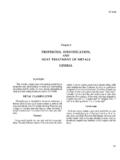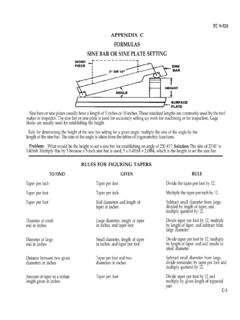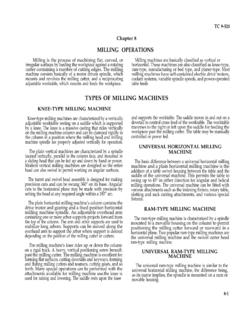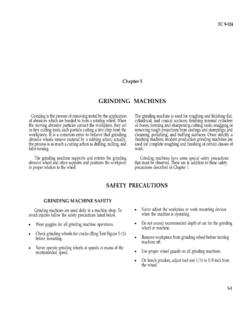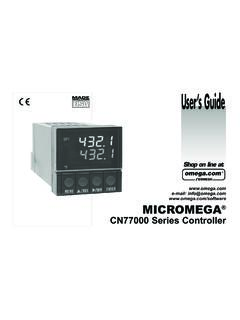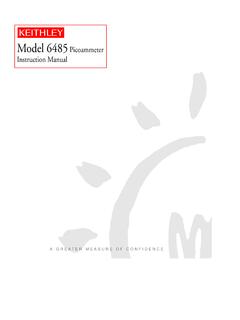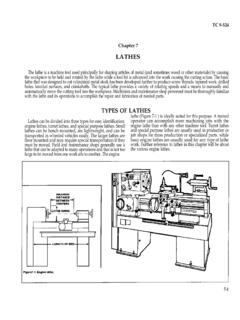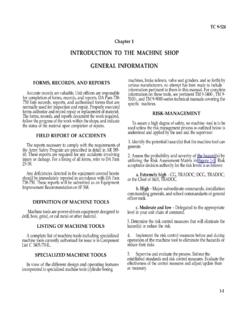Transcription of DRILLING MACHINES GENERAL INFORMATION
1 TC 9-524. Chapter 4. DRILLING MACHINES . GENERAL INFORMATION . PURPOSE USES. This chapter contains basic INFORMATION pertaining to DRILLING A DRILLING machine , called a drill press, is used to cut holes MACHINES . A DRILLING machine comes in many shapes and into or through metal, wood, or other materials (Figure 4-1). sizes, from small hand-held power drills to bench mounted DRILLING MACHINES use a DRILLING tool that has cutting edges at and finally floor-mounted models. They can perform its point. This cutting tool is held in the drill press by a chuck operations other than DRILLING , such as countersinking, or Morse taper and is rotated and fed into the work at variable counterboring, reaming, and tapping large or small holes. speeds. DRILLING MACHINES may be used to perform other Because the DRILLING MACHINES can perform all of these operations. They can perform countersinking, boring, operations, this chapter will also cover the types of drill bits, counterboring, spot facing, reaming, and tapping (Figure 4-2).
2 Took, and shop formulas for setting up each operation. drill press operators must know how to set up the work, set speed and feed , and provide for coolant to get an acceptable Safety plays a critical part in any operation involving finished product. The size or capacity of the DRILLING machine power equipment. This chapter will cover procedures for is usually determined by the largest piece of stock that can be servicing, maintaining, and setting up the work, proper center-drilled (Figure 4-3). For instance, a 15-inch DRILLING methods of selecting tools, and work holding devices to get machine can center- drill a 30-inch-diameter piece of stock. the job done safely without causing damage to the equipment, Other ways to determine the size of the drill press are by the yourself, or someone nearby. largest hole that can be drilled, the distance between the spindle and column, and the vertical distance between the worktable and spindle. 4-1. TC 9-524.
3 The work. feed pressure applied to the sleeve by hand or power causes the revolving drill to cut its way into the work a few thousandths of an inch per revolution. The column of most drill presses is circular and built rugged and solid . The column supports the head and the sleeve or quill assembly. The head of the drill press is composed of the sleeve, spindle, electric motor, and feed mechanism. The head is bolted to the column. The worktable is supported on an arm mounted to the column. The worktable can be adjusted vertically to accommodate different heights of work. or it may be swung completely out of the way. It may be tilted up to 90 in either direction, to allow for long pieces to be end or angled drilled. The base of the DRILLING machine supports the entire machine and when bolted to the floor, provides for vibration-free operation and best machining accuracy. The top of the base is similar to a worktable and maybe equipped with T-slots for mounting work too large for the table.
4 CARE OF DRILLING MACHINES . Lubrication Lubrication is important because of the heat and friction generated by the moving parts. Follow the manufacturer's manual for proper lubrication methods. Clean each machine after use. Clean T-slots. grooves. and dirt from belts and pulleys. Remove chips to avoid damage to moving parts. Wipe all spindles and sleeves free of grit to avoid damaging CHARACTERISTICS the precision fit. Put a light coat of oil on all unpainted surfaces to prevent rust. Operate all MACHINES with care to All DRILLING MACHINES have the following construction avoid overworking the electric motor. characteristics (Figure 4-4): a spindle. sleeve or quill. column, head, worktable, and base. Special Care The spindle holds the drill or cutting tools and revolves Operations under adverse conditions require special care. If in a fixed position in a sleeve. In most DRILLING MACHINES , MACHINES are operated under extremely dusty conditions.
5 The spindle is vertical and the work is supported on a operate at the slowest speeds to avoid rapid abrasive wear on horizontal table. the moving parts and lubricate the MACHINES more often. Under extreme cold conditions, start the MACHINES at a slow The sleeve or quill assembly does not revolve but may speed and allow the parts and lubricants to warm up before slide in its bearing in a direction parallel to its axis. increasing the speeds. Metal becomes very brittle in extreme When the sleeve carrying the spindle with a cutting tool cold. so do not strike the MACHINES with hard tools. Extreme is lowered, the cutting tool is fed into the work: and when heat may cause the motor to overheat. so use intermittent. or it is moved upward, the cutting tool is withdrawn from on and off, operations to keep the motor running cool. 4-2. TC 9-524. TYPES OF DRILLING MACHINES Reaming, counterboring, and counter-sinking may require slower speeds than DRILLING and may not be able to be There are two types of DRILLING MACHINES used by performed for all materials on these MACHINES .
6 Maintenance personnel for repairing and fabricating needed parts: hand- feed or power- feed . Other types of DRILLING Hand- feed MACHINES , such as the radial drill press. numerically controlled DRILLING machine . multiple spindle DRILLING The hand- feed DRILLING MACHINES (Figure 4-5) are the machine , gang DRILLING machine , and turret drill press, are all simplest and most common type of DRILLING MACHINES in use variations of the basic hand and power- feed DRILLING today. These are light duty MACHINES that are hand-fed by the MACHINES . They are designed for high- speed production and operator, using a feed handle. so that the operator is able to industrial shops. feel the action of the cutting tool as it cuts through the workpiece. These DRILLING MACHINES can be bench or floor- DRILLING depth is controlled by a depth-stop mechanism mounted. They are driven by an electric motor that turns a located on the side of the spindle. The operator of the drive belt on a motor pulley that connects to the spindle machine must use a sense of feel while feeding the cutting pulley.
7 Hand- feed MACHINES are essentially high- speed tool into the work. The operator must pay attention and be MACHINES and are used on small workplaces that require alert. to when the drill breaks through the work, because of holes 1/2 inch or smaller. Normally, the head can be moved the tendency of the drill to grab or snag the workpiece, up and down on the column by loosening the locking bolts. wrenching it free of its holding device. Due to the high speed which allows the DRILLING machine to drill different heights of of these MACHINES , operations that require DRILLING speeds less work. than 450 revolutions per minute cannot be performed. 4-3. TC 9-524. Power- feed The power- feed DRILLING MACHINES (Figure 4-6) are usually larger and heavier than the hand- feed . They are equipped with the ability to feed the cutting tool into the work automatically, at a preset depth of cut per revolution of the spindle, usually in thousandths of an inch per revolution.
8 These MACHINES are used in maintenance shops for medium- duty work, or work that uses large drills that require power feeds. The power- feed capability is needed for drills or cutting took that are over 1/2 inch in diameter, because they require more force to cut than that which can be provided by using hand pressure. The speeds available on power- feed MACHINES can vary from about 50 RPM to about 1,800 RPM. The slower speeds allow for special operations, such as counterboring, countersinking, and reaming. The sizes of these MACHINES generally range from 17-inch to a 22-inch center- DRILLING capacity, and are usually floor mounted. They can handle drills up to 2 inches in diameter, which mount into tapered Morse sockets. Larger workplaces are usually clamped directly to the table or base using T-bolts and clamps, while small workplaces are held in a vise. A. depth-stop mechanism is located on the head, near the spindle, to aid in DRILLING to a precise depth.
9 SAFETY PRECAUTIONS. GENERAL . Do not support the workplaces by hand. Use a holding DRILLING MACHINES have some special safety precautions device to prevent the workpiece from being tom from the that are in addition to those listed in Chapter 1. operator's hand. DRILLING machine SAFETY Never make any adjustments while the machine is operating. DRILLING MACHINES are one of the most dangerous hand Never clean away chips with your hand. Use a brush. operated pieces of equipment in the shop area. Following safety procedures during DRILLING operations will help Keep all loose clothing away from turning tools. eliminate accidents, loss of time, and materials. Listed below are safety procedures common to most types of DRILLING Make sure that the cutting tools are running straight MACHINES found in the machine shop. before starting the operation. 4-4. TC 9-524. Never place tools or equipment on the DRILLING tables. Remove all chuck keys and wrenches before operating.
10 Keep all guards in place while operating. Always wear eye protection while operating any DRILLING MACHINES . Ease up on the feed as the drill breaks through the work to avoid damaged tools or workplaces. TOOLS AND EQUIPMENT. Common twist drill sizes range from (wire gage size TWIST DRILLS No. 80) to inches in diameter. Larger holes are cut by special drills that are not considered as twist drills. The Twist drills are the most common cutting tools used with standard sizes used in the United States are the wire gage DRILLING MACHINES . Twist drills are designed to make round numbered drills, letter drills, fractional drills, and metric drills holes quickly and accurately in all materials. They are called (See Table 4-1, in Appendix A). Twist drills can also be twist drills mainly because of the helical flutes or grooves that classified by the diameter and length of the shank and by the wind around the body from the point to the neck of the drill length of the fluted portion of the twist drill .
